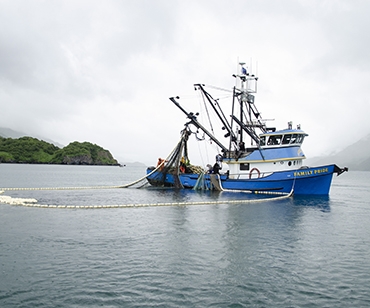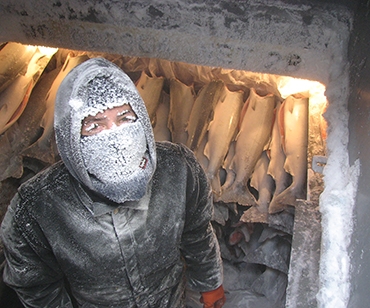Sponsored Content
Frozen Seafood - Debunking The Myth
Providing flavorful and sustainable varieties to chefs year-round
Conventional wisdom regarding seafood tells us that ultimate quality is the domain of the fresh catch. Alternatively, seafood that’s been frozen is dismissed as inferior, preferred primarily for convenience, longer shelf life and lower price. In spite of these enduring notions, the ways in which wild-caught seafood is harvested and delivered to market has changed... significantly.
Performance Is Everything
Without a doubt, the remarkable flavor, texture, and overall performance of freshly caught seafood is what creates demand and attracts a premium price. As such, discerning chefs want to know where seafood comes from, how it was caught, whether it’s been properly handled, and that temperatures have been carefully monitored and maintained from boat to kitchen.
With considerably improved flash-freezing technologies, the culinary attributes associated with freshly caught seafood are being preserved without compromise. This allows chefs to maintain culinary quality, keep the most highly sought after varieties of seafood on their menus year-round, use only what’s needed when it’s needed, and even cook from frozen. This provides a cost-effective way to manage seafood consumption in the kitchen, and ensure ongoing patron satisfaction and loyalty front-of-house.

When asked about the culinary impact of frozen-fresh seafood, Barton Seaver, renowned chef, author, and seafood educator offers, “The key operational benefits are higher quality, great variety, lower cost and undeniable convenience. I can use precisely what’s needed without concern for spoilage.”
According to Ned Bell, Executive Director of Culinary at The Vancouver Club, Founder of Chef for Oceans, and a celebrated advocate for sustainable seafood, “The old adage that ‘fresh is best’ no longer holds true. With the remarkable flash-freezing technologies available today, all of the freshness, flavor and quality that’s available at the time of harvest is locked in.”
Virtually No Difference
What’s surprising is that, when comparisons between refrigerated and frozen-fresh seafood are made, both chefs and consumers find it difficult to discern a significant difference in quality.
A recent study conducted by the Food Innovation Center at Oregon State University reinforces this finding. When they measured the differences in quality between fresh and frozen-fresh Alaska scallops, statistics revealed there were no significant differences.
These remarkable results have been achieved through significant improvements in freezing technologies used aboard boats and in dockside processing facilities—giving fishermen the ability to preserve the intrinsic qualities of wild-caught seafood immediately following harvest. Specifically, the fish is flash-frozen and ice-glazed, effectively stopping the clock on quality loss and degradation. When it comes to freshly caught and refrigerated seafood, the clock keeps ticking. Deterioration begins on the boat and continues until the seafood is cooked.
Based on statistics reported by Datassential, it is startling to learn that 50% of operators who purchase refrigerated seafood end up freezing it, raising the question of why they didn’t buy high-quality frozen-fresh seafood in the first place.
Bluzette Carline, Marketing Director for Beaver Street Fisheries, has been taking note of these dynamics, “We’ve seen an increasing number of people taking an interest in frozen-fresh seafood. They’re beginning to acknowledge little to no difference from refrigerated and, at the same time, appreciate the flexibility, versatility, and economic benefits that frozen-fresh seafood represents.”
Ensuring Sustainable Fisheries
When you consider the longstanding consumer belief that fresh is best and that wild-caught seafood is preferred over farmed by a factor of 5:2 (Datassential), it’s essential for environmental and sustainability issues to be resolved.
What’s frequently overlooked is that highly prized wild-caught seafood must be harvested according to their natural life cycles, demanding a process that is carefully managed and timed to avoid intrusions during critical reproductive cycles. With year-round demand, new technologies in freezing allow harvesters and processors to store and sell sustainably harvested fish throughout the year.
Responsible and sustainable harvesting is the number one priority for fisheries in Alaska, a point of origin for wild-caught seafood that is highly regarded by consumers. Whether the fish is refrigerated or frozen-fresh, the word Alaska on a menu implies the fish is fresh, healthy and great tasting (Datassential), providing greater flexibility for operators to menu frozen wild-caught year-round.
As flash freezing technologies improve and become more accessible, the ability to bring an even greater variety of seafood products to market becomes feasible. Coupled with increasing awareness and educational opportunities, chefs have even greater freedom to explore exciting new menu options, allowing them to introduce intriguing, flavorful and eye-catching seafood experiences to their patrons. Additionally, as increasing numbers of socially conscious consumers learn to appreciate the benefits associated with flash-freezing, a new paradigm that celebrates frozen-fresh seafood will emerge.
For recipes and more, visit www.alaskaseafood.org/foodservice
Seriously Cold

Flash freezing preserves the flavor, texture and nutritional value of wild-caught seafood. These are some of the latest freezing technologies currently employed by fishermen and seafood processors to maintain the integrity of their products:
- Super Freezing
Fish are immediately frozen at temperatures reaching -76º F while boats are still at sea, preserving key nutrients such as Omega-3 fatty acids that will otherwise deteriorate.
- Cryogenic Freezing
A more advanced blast freezing process, fish are sprayed or immersed in carbon dioxide or liquid nitrogen, minimizing ice crystals that can damage cellular structure and integrity.
- Impingement Freezing
Best suited to fish fillets, high-velocity air jets blast top and bottom surfaces, promoting faster freezing times. Faster freezing minimizes damage while preserving texture and taste.
- Log in or register to post comments
